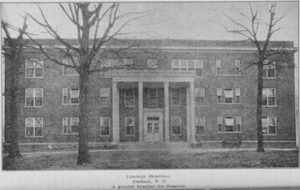
Lincoln Hospital
*The opening of Lincoln Hospital is celebrated on this date in 1901. Lincoln was the third hospital for Blacks in North Carolina. It was located in Durham, N.C., and despite their ability to pay, it was open to all patients.
The Lincoln School of Nursing opened the following year with Julia Latta, a St. Agnes School of Nursing graduate in Raleigh, the first director. Patty Carter became their director of nursing in 1911. She was born in 1875 and was the daughter of Hawkins W. Carter, who served Warren County as a representative and state senator during the Reconstruction era.
She obtained her education from Shaw University, St. Agnes Hospital, and Lincoln Hospital in New York City. During her 37 years at Lincoln, she served in nearly every leadership capacity. She was known to prepare meals in the kitchen, dispense medicines from the pharmacy, mop floors, and help out where needed. In 1927, William K. Boyd, in The Scalpel, attributed the institution's success to her dedication and countless hours of work.
Just as nursing schools were segregated by race at the turn of the century, so was the North Carolina Nurses Association when it was founded in 1902. By the early 20th century, North Carolina had three strong schools of nursing for Blacks: St. Agnes in Raleigh, Lincoln in Durham, and Good Samaritan in Charlotte, and African American women saw a need for their professional association for registered nurses. In August 1920, Carrie Early Broadfoot and four other African American nurses from North Carolina attended a meeting of the National Association of Negro Graduate Nurses in Washington, DC. They began discussing the formation of a state association. In January 1923, the North Carolina Association of Negro Registered Nurses was founded in Winston-Salem.
The organization grew despite lacking funds, staff, or permanent office space. The organization provided African American nurses opportunities for professional growth—educational and employment discrimination deeply concerned association members. By 1937, Black nurses seeking employment in community health could only find jobs in Asheville, Charlotte, Greensboro, Raleigh, Weldon, Wilmington, and Winston-Salem. By the 1940s, Jim Crow racial injustice was being questioned by more and more people. Organized nursing was at the forefront of breaking down racial barriers in North Carolina. During this decade, leaders of the North Carolina Nurses Association and the North Carolina Colored Graduate Nurses Association created a plan to merge.
In 1949, NCCGNA voted itself out of existence, and NCNA voted to open its membership to all registered nurses in North Carolina. It took over a decade after the merger of the professional organizations for white nursing schools to accept Black women. One registered nurse's account of overcoming racial barriers to realize her dream is the following. St Agnes Hospital Founded by Sarah Hunter, wife of Saint Augustine's fourth principal, the original 1895 building housed the only nurse teaching hospital for African Americans between Atlanta and Washington, D.C., but was severely damaged by fire; students quarried stone and started the current building in 1905 under the direction of the Rev. Henry Beard Delany; it became a 75-bed center that opened in 1908; after a $5 million renovation it will next become an administrative center for the college.
1315 Oakwood Ave; 919-516-4000.